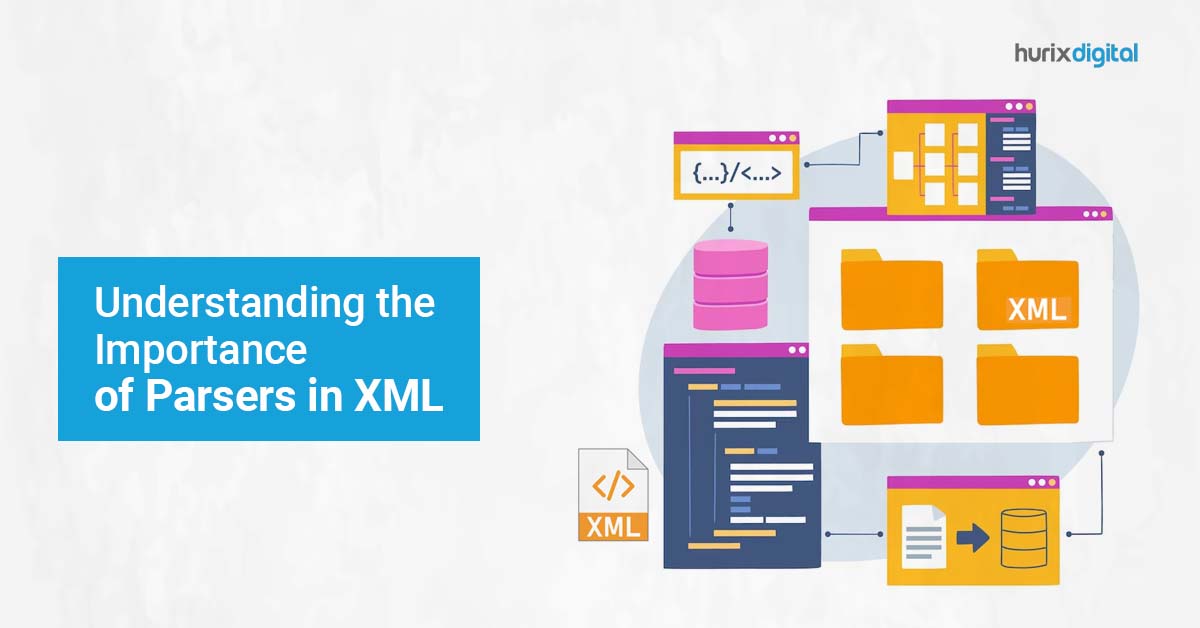
Understanding the Importance of Parsers in XML
Summary
Learn about the critical role of parsers in XML processing, including how they help in data extraction, transformation, and integration across various applications.
A parser in XML is software that is responsible for reading and processing XML documents. Its main purpose is to validate the structure of the document and to extract data from it in a way that can be easily processed by other software applications.
Table of Contents:
- What are the Two Types of XML Parsers?
- Eight Essential Rules to Follow for XML Standards
- What is Character Encoding
- What are the Advantages of Using UTF-8 for XML Documents
- What is UTF-8?
- What are the Advantages of UTF-8
- What is the Difference Between ASCII and UTF-8 Characters
There are two types of XML parsers: SAX and DOM.
- A SAX (Simple API for XML) parser reads an XML document sequentially and generates events, which are notifications of the parser’s progress through the document. This type of parser is generally faster and uses less memory than a DOM parser. However, it is less convenient for random access to the document’s content.
- A DOM (Document Object Model) parser loads the entire XML document into memory and creates a tree-like structure that represents the document’s elements and their relationships. This type of parser is slower and uses more memory than a SAX parser but provides random access to the document’s content.
The significance of a parser in XML lies in its ability to validate the structure of an XML document and extract data from it in a way that can be easily processed by other software applications. A parser ensures that the XML document adheres to the rules of the XML standard and that the data within the document is properly formatted. It also makes it possible to access and manipulate the data in the document programmatically, which is essential for many types of software applications that deal with XML data.
Eight Essential Rules to Follow for XML Standards
XML (Extensible Markup Language) is a standard for creating and sharing structured data in a machine-readable format. The rules of the XML standard define how an XML document should be structured and formatted. Here are some of the key rules:
- XML documents must have a single root element.
- All XML elements must be properly nested within their parent elements.
- XML elements must be properly closed. An element can be closed either with a closing tag or with a self-closing tag.
- XML tags are case-sensitive. For example, “Title” and “title” are considered two different tags.
- XML attribute values must be enclosed in quotes.
- XML documents must use a specific character encoding, such as UTF-8 or UTF-16.
- XML documents can define their own custom tags and attributes using a Document Type Definition (DTD) or an XML Schema.
- XML documents can also include comments using the <!– –> syntax.
By adhering to these rules, an XML document can be easily processed and understood by other software applications, regardless of the programming language or platform being used.
What is Character Encoding
Character encoding is the process of assigning a unique numerical value (code point) to each character in a given set of characters. In the context of XML, character encoding refers to the method used to represent the characters in an XML document as a sequence of bytes that can be transmitted or stored.
There are several character encoding schemes available, such as UTF-8, UTF-16, ISO-8859-1, and ASCII. However, the most commonly used character encoding for XML is UTF-8 (Unicode Transformation Format 8-bit).
UTF-8 is a variable-length encoding scheme that uses one to four bytes to represent each character in the Unicode character set, which includes most of the world’s writing systems. UTF-8 is backward compatible with ASCII, which means that ASCII-encoded characters can be represented in UTF-8 using a single byte.
What are the advantages of using UTF-8 for XML documents?
- It supports all the characters in the Unicode character set, including those used in non-Latin scripts.
- It is backward compatible with ASCII, which ensures that existing ASCII-encoded documents can be easily migrated to UTF-8.
- It is widely supported by modern software applications, programming languages, and platforms.
- It provides a compact representation of text that reduces storage and transmission costs.
When creating an XML document, it is important to specify the character encoding being used, either in the XML declaration at the beginning of the document or in the HTTP header if the document is being transmitted over the web. This ensures that the receiving software application can correctly interpret the document’s content.
What is UTF-8?
UTF-8 (Unicode Transformation Format, 8-bit) is a character encoding scheme that is widely used for representing characters in a variety of electronic communication protocols and file formats, including XML.
UTF-8 is designed to be backward-compatible with ASCII, which means that any text that can be represented in ASCII can also be represented in UTF-8 using a single byte. However, UTF-8 can also represent any Unicode character, which includes characters from most of the world’s writing systems.
In UTF-8, each character is represented by a variable-length sequence of one to four bytes, depending on its Unicode code point value. The first byte of each sequence indicates the number of bytes used to represent the character, and subsequent bytes contains the binary representation of the character’s Unicode code point value.
UTF-8 has several advantages over other character encoding schemes, including:
- Compatibility with ASCII: UTF-8 is fully compatible with ASCII, which ensures that existing ASCII-encoded documents can be easily migrated to UTF-8 without losing any data.
- Support for all Unicode characters: UTF-8 can represent any Unicode character, including those used in non-Latin scripts and special symbols.
- Space efficiency: UTF-8 uses a variable-length encoding scheme that minimizes the amount of space required to store or transmit text.
- Robustness: UTF-8 is designed to be robust in the face of errors and can detect and recover from many common errors that can occur during transmission or storage.
Overall, UTF-8 is a widely used and versatile character encoding scheme that is well-suited for representing text in a wide range of contexts, including XML documents.
What is the Difference between ASCII and UTF-8 Characters?
ASCII and UTF-8 are both character encoding schemes that are used to represent characters as binary data. However, there are some key differences between the two.
ASCII, or American Standard Code for Information Interchange, is a 7-bit character encoding scheme that was first developed in the 1960s. It is a very basic encoding scheme that can only represent 128 characters, including letters, numbers, punctuation, and some special control characters. ASCII is still commonly used in many computer systems and programming languages today.
UTF-8, or Unicode Transformation Format 8-bit, is a variable-length character encoding scheme that was developed in the 1990s. UTF-8 is capable of representing any character in the Unicode standard, which includes over 143,000 characters from a wide range of scripts and languages. UTF-8 is backwards compatible with ASCII, which means that any ASCII character can be represented using a single byte in UTF-8.
One of the main differences between ASCII and UTF-8 is their character sets. ASCII is a very limited character set that can only represent characters used in the English language and a few special characters. UTF-8, on the other hand, can represent any character used in any language in the world.
Another difference is in the way that characters are represented. ASCII uses a fixed-length encoding scheme, where each character is represented using a single byte. UTF-8, on the other hand, uses a variable-length encoding scheme, where different characters may require different numbers of bytes to represent.
In summary, while ASCII is a basic character encoding scheme that can only represent a limited set of characters, UTF-8 is a more advanced and flexible encoding scheme that can represent any character in the Unicode standard.
Related Article – 6 Must-Have XML Add-ons and Integration Tools for Better Productivity

Vice President – Content Transformation at HurixDigital, based in Chennai. With nearly 20 years in digital content, he leads large-scale transformation and accessibility initiatives. A frequent presenter (e.g., London Book Fair 2025), Gokulnath drives AI-powered publishing solutions and inclusive content strategies for global clients




